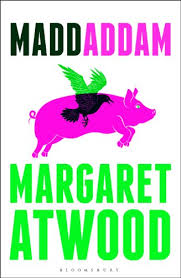
Maddaddam is the third book in a Margaret Atwood apocalyptic science fiction trilogy that began with Oryx and Crake, followed by a prequel, The Year of the Flood. Maddaddam is a sequel to both of the earlier books.
The novels are set in a future that could be just around the corner. The Year of the Flood is set in a world on the brink of collapse due to environmental degradation and the rampant and totally unethical business operations of a mega multinational. Everything has been privatised, including law enforcement, and government welfare services are non-existent.
The story revolves around a commune of refugees from the world who live in an abandoned apartment block. They grow food on its rooftop and recycle the detritus of society. The commune is led by Addam, who is set on getting his followers ready for the inevitable collapse of civilisation. Much of the story concerns Toby, a woman who escapes to the commune to avoid certain rape and murder at the fast food restaurant where she had worked.
Oryx and Crake is set after a virus, created by scientific genius Crake, decimates the world’s population. Only a few humans survive, along with a small group of a new species of genetically engineered humans. A species created by Crake so they are called Crackers. They are resistant to the plague. The Crackers are a gentle and innocent species that don’t require clothing and eat the abundant genetically engineered foliage that has spread across the planet. The Crackers have built-in defences like urine that warns off dangerous animals, and they have a big desire to procreate.
Oryx and Crake achieved the rare distinction of being a science fiction novel that was shortlisted for the Booker Prize.
In Maddaddam, Toby and Zeb join up with the Crackers to survive the threat of Painballers – drug addicted psychopathic killers created for the future’s violent entertainments. But Maddaddam is not just a thriller/adventure novel, it is a contemplation on the propensity of humans to destroy themselves and the world around them. The novel asks if the world would be a better place without humans, instead filled with a more community-minded and environmentally friendly species like the Crackers. A world were a less dominate main life form is on more of a level playing field with other genetically engineered animals.
Maddaddam differs from the other two novels in the trilogy with its humour. Much of the humour is provided by the naive interactions of the Crackers with the humans. The Cracker’s lack of understanding of human emotions such as greed, lead to many questions that can only be answered with concepts unfamiliar to them.
As with The Year of the Flood, Toby is a very engaging main character. She has the strength of mind to do what she thinks is right while dealing with many personal insecurities, especially around her relationship with Zeb. She appears to be the polar opposite of Zeb, who is full of bravado about what he has done to survive.
As usual, Atwood’s prose flows like a gentle, meandering creek. She is so easy to read. This would have helped Maddaddam top a Goodreads’ poll as the best science fiction novel of 2013.
Maddaddam ends the trilogy with hope. Hope for an Earth that might rebound and sustainably provide the needs for all its life forms, including the few surviving humans. It is a worthy final book in an engrossing and thought-provoking trilogy, and is one of the best science fiction apocalyptic series ever written.
The novels all have the added advantage of being standalone volumes without obvious hanging endings that require the reading of the other novels.
